Arc: The Internet Computer
How the Arc web browser is paving the way for the future of consumer computers
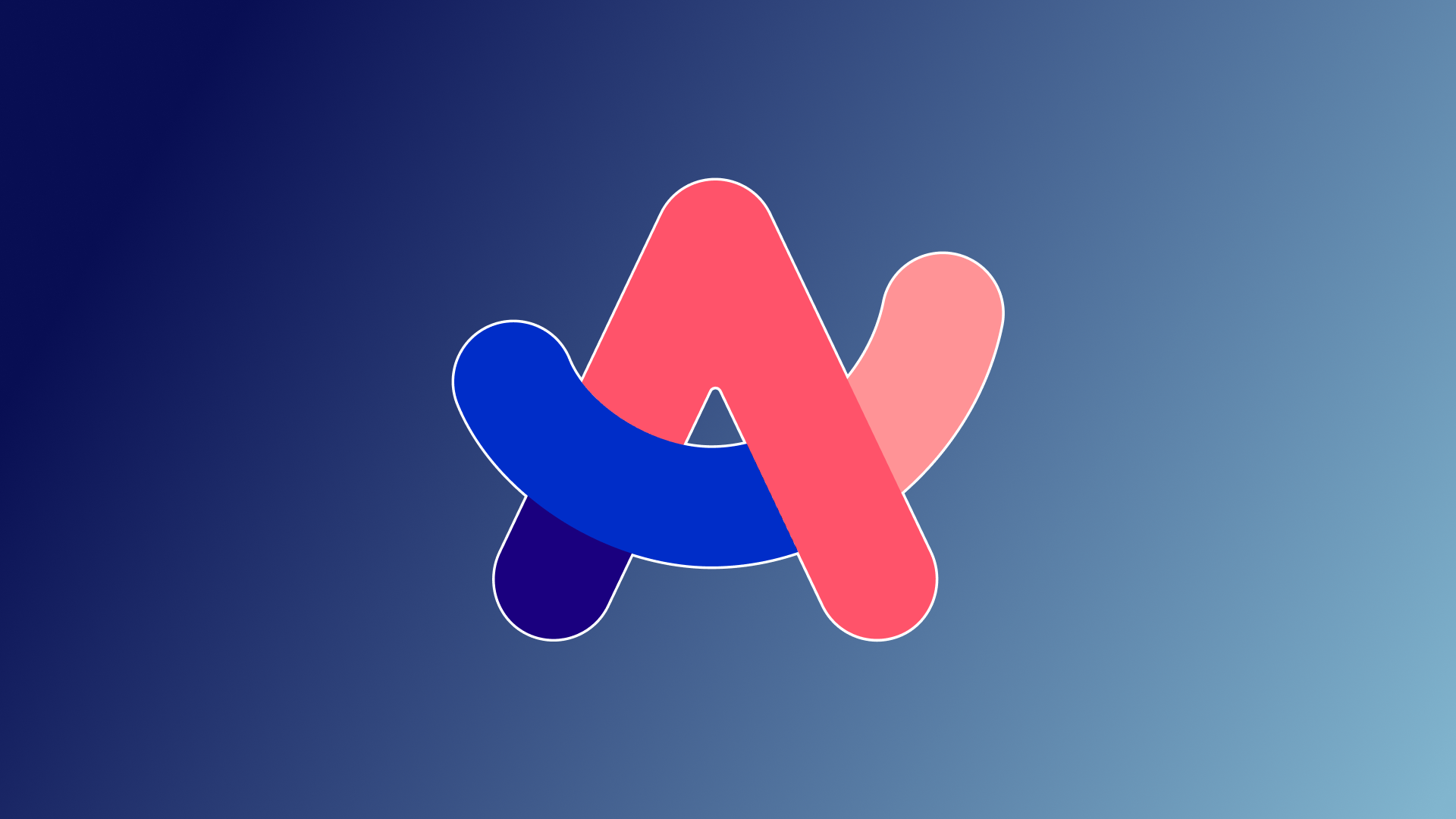
20 Years of the Same Thing
The internet has grown significantly in the last twenty years. What was once just static web pages with facts is now a bustling cyber metropolis where we write essays, share photos of food, and buy airline tickets. It’s something we use every day and take for granted. What’s interesting is that in the last twenty years of the internet’s evolution, the way we experience it has stayed mostly the same. Web browsers have certainly changed in appearance and performance, but the tab model and disconnect from the rest of the computer have stayed. The Browser Company making the Arc Browser has plans to change that and has the ambitious goal of creating an “Internet Computer.” Before we get ahead of ourselves, let’s have a brief overview of Arc and its features.
Tabs, Folders, and Spaces
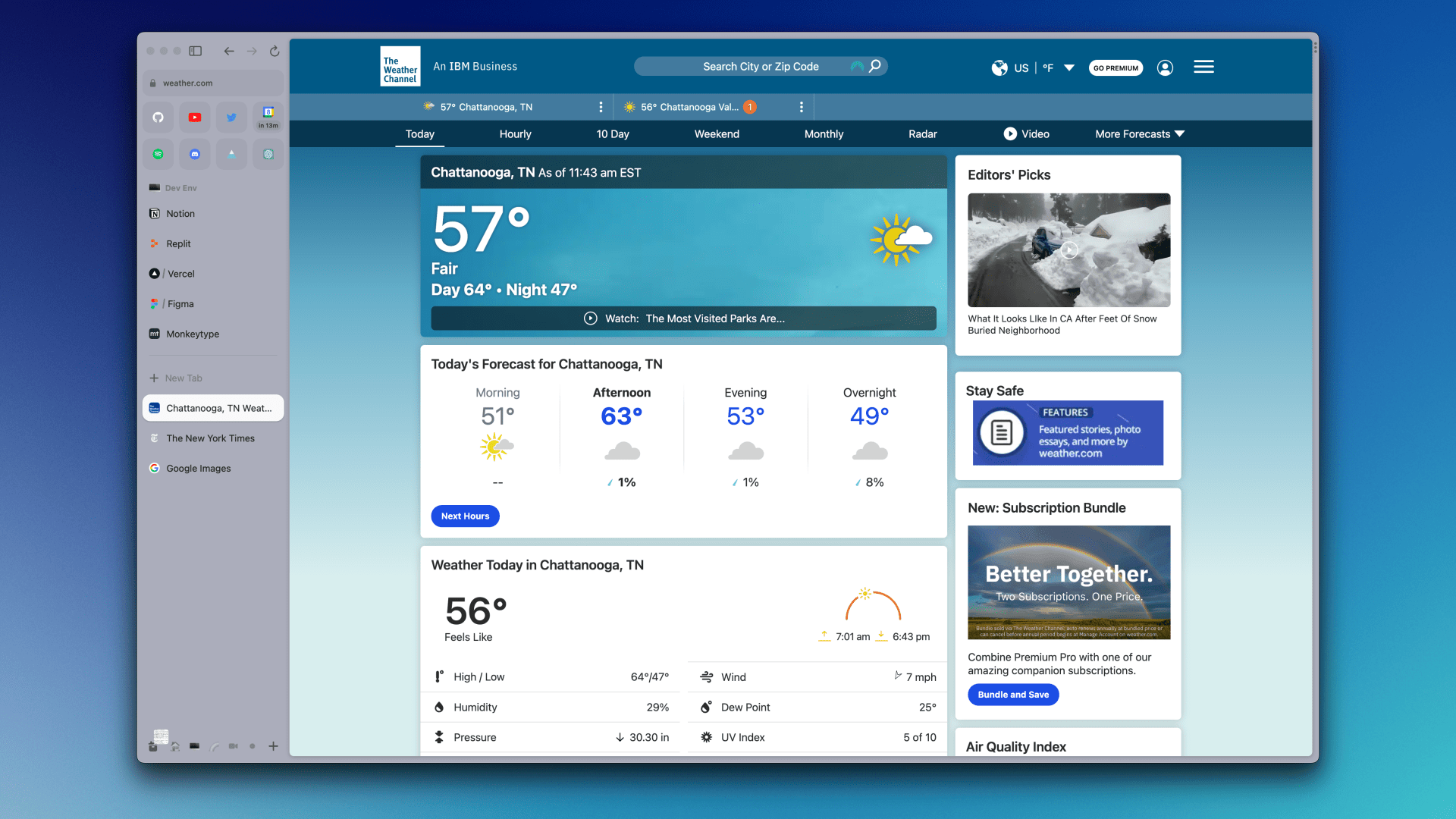
One of the fundamental differences between Arc and other browsers is how it handles tabs. Instead of a row of tabs at the top of a window, Arc keeps them all in a sidebar. I genuinely believe there is a strong UX decision being made here: organization is simply easier to accomplish with a side menu than it is with a top menu. Beyond that, Arc uses a “Pinned Tabs” and “Today’s Tabs” approach to organizing your website. You may often feel hesitant to close a website because you might need it later. If you do, you can move it to the pinned tabs. When you feel like you don’t need it, then you can remove it from pinned tabs. Anything that stays in today’s tabs can be automatically cleared after a certain amount of time, or you can click a button to wipe them all out. This is powerful because it makes the decision of what is important and what isn’t easy for people to make.
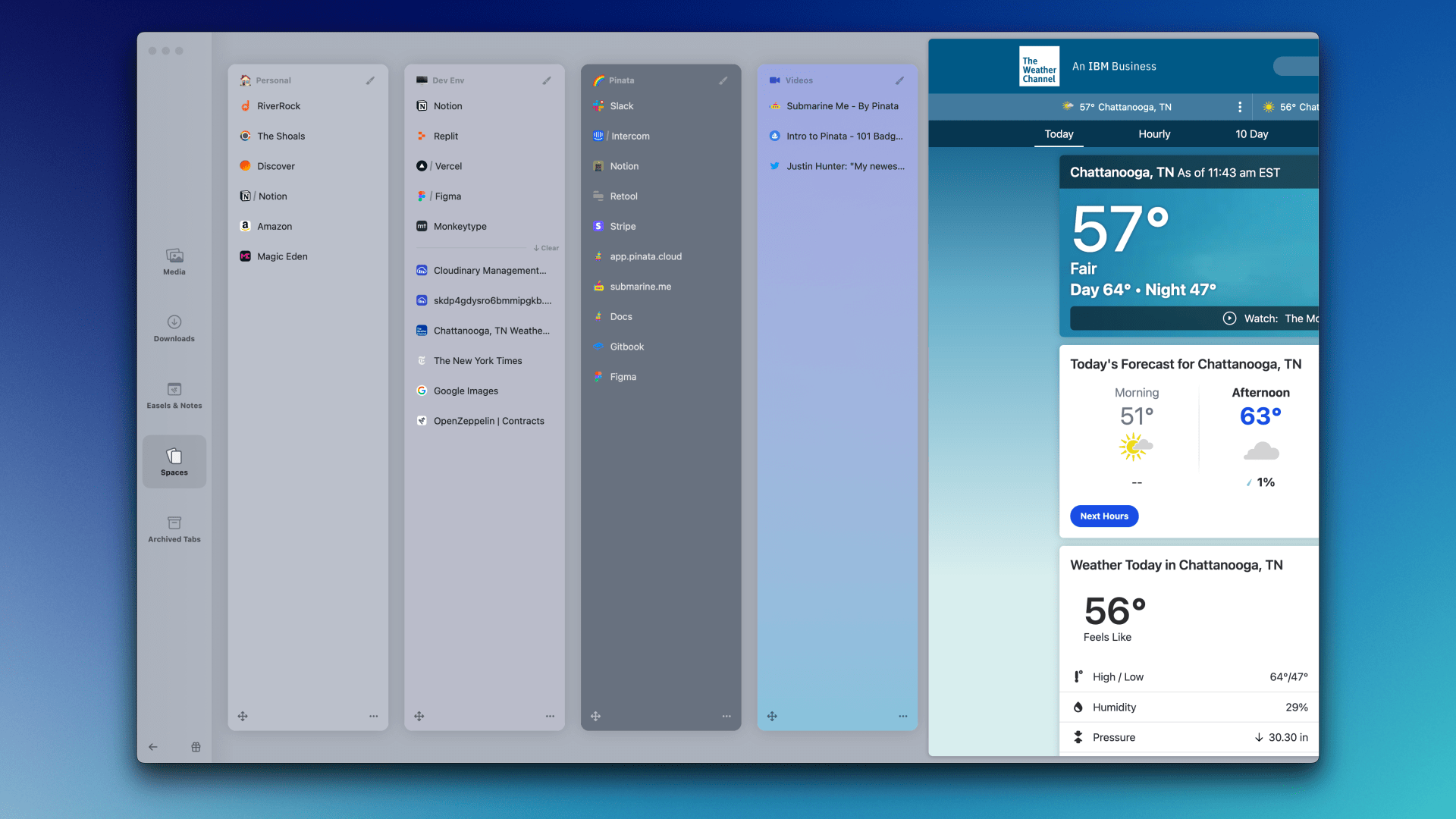
Of course, you may have lots of websites that you need to keep pinned, and for that, Arc has Folders and Spaces. Folders work like any other bookmark folder, where you can store as many as you want with sub-folders as well. This can be useful if you have a lot of sites that need to be referenced for a project. Folders work to a degree, but even still, you can have too many folders. That’s where spaces come in. Spaces are designed to be different workspaces for whatever you do on the internet. You could have a shopping space, an entertainment space, a developer space, anything really. You can customize the appearance, name, icon, and of course, the pinned tabs and folders for each one. Arc makes it simple to swipe between spaces and re-organize them to fit your needs.
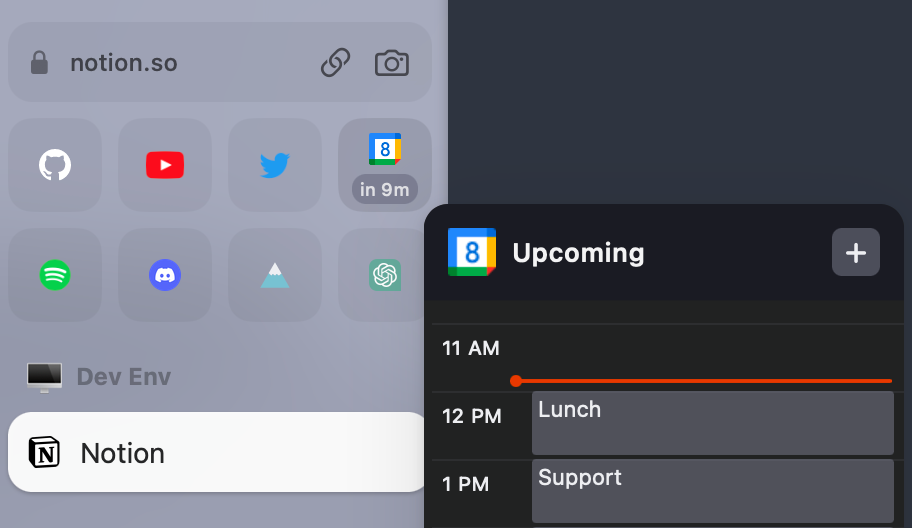
Favorites are special in that they are in nice little squares are the top of the sidebar no matter what space you are in, so for instance if you use Spotify a lot then that would be an ideal favorite app or website. They also have a preview feature when you hover over them for selective sites, e.g. Google Calendar will show you a brief schedule window.
These simple changes can drastically clear up and organize your internet browser if you typically have thirty Chrome tabs open, and it’s seriously good. There are even more reasons why this feature set is so important, but we’ll get back to that later.
Split View
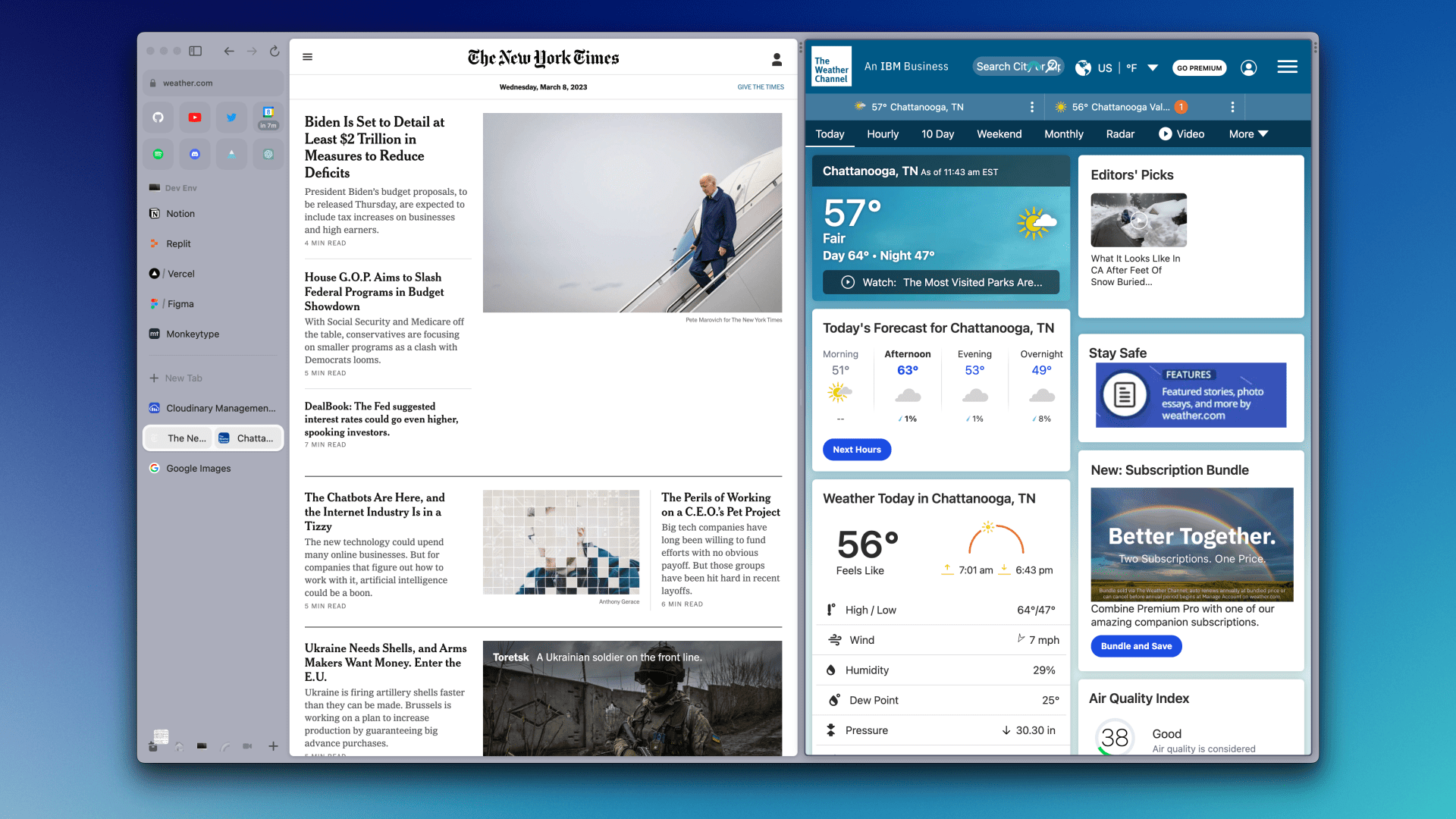
Another killer feature on Arc is split views. With a few clicks, you can easily have side-by-side panels of two different websites. You can even pin these dual tabs if you have to reference them quickly. You can actually do more than just two; depending on how big your screen is, you can go crazy! Personally, I use this all the time when reading an article while taking notes or moving information from one app to another. The Arc team recently released vertical splits as well, perhaps enough persuasion to get a vertical monitor.
Managing split views is effortless, with the ability to expand tabs to full screen, delete or replace a pane, resize panes, and rearrange them. It’s such a simple feature but executed so well.
Peek View
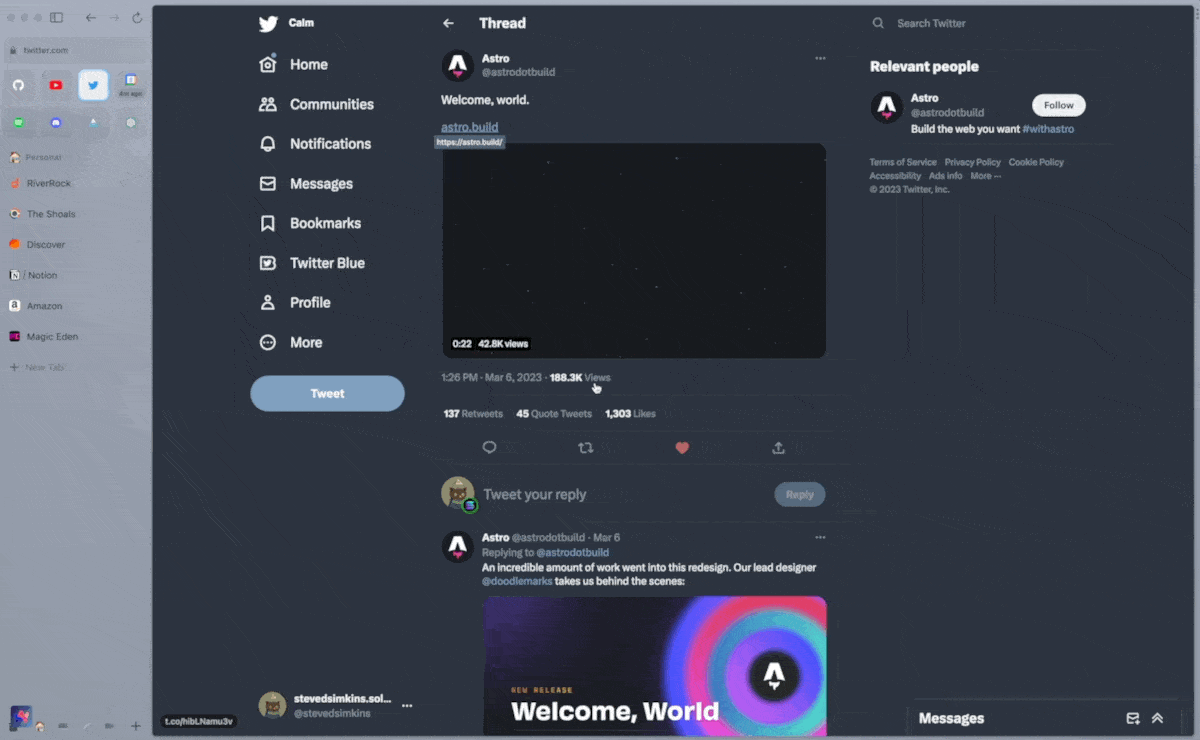
Peek is a new feature for Arc but perhaps one of my favorites. When you click on a link, instead of taking you to a new tab or taking you off the current site, a smaller window pops up and allows you to see the content, where you can either close it or expand it into a full tab. You could be browsing Twitter, see someone reference an article, take a quick peek, and be done! It’s a great way to reduce tab clutter, with a world-class UX.
Easels
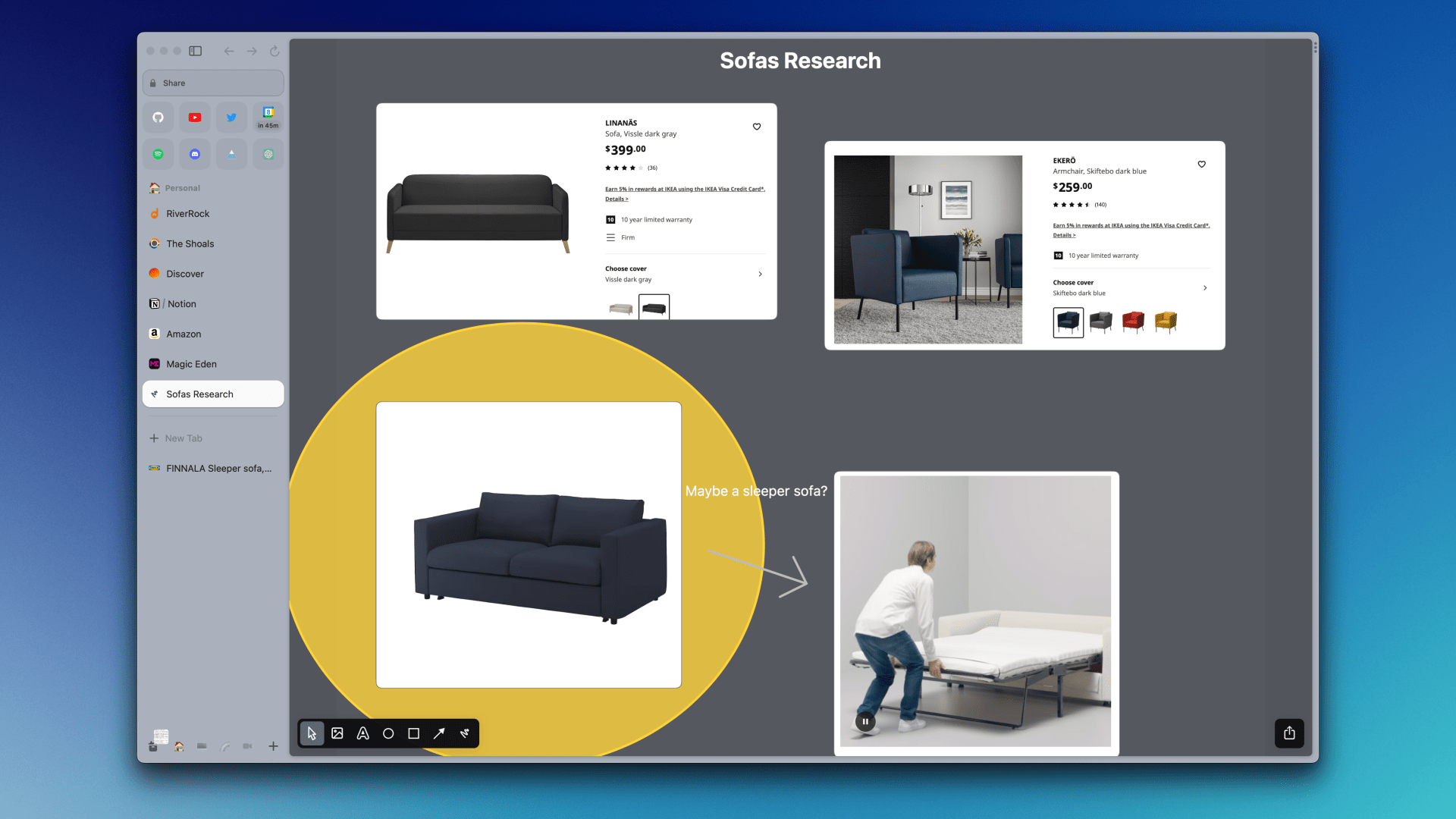
Easels are something completely unique to Arc and have some pretty impressive abilities. The concept is like internet chalkboards. You can snip pieces of websites, add them to an easel, then add other things like your images, text, shapes, etc. Arc provides a great shortcut (that can be customized), where all you have to do is hold down Command and Shift, then click & drag across the screen to select what you want to snip. Then it will prompt what easel you want to add the snippet to, or if you want to make a new one. Easels can also be made public and shared with other people!
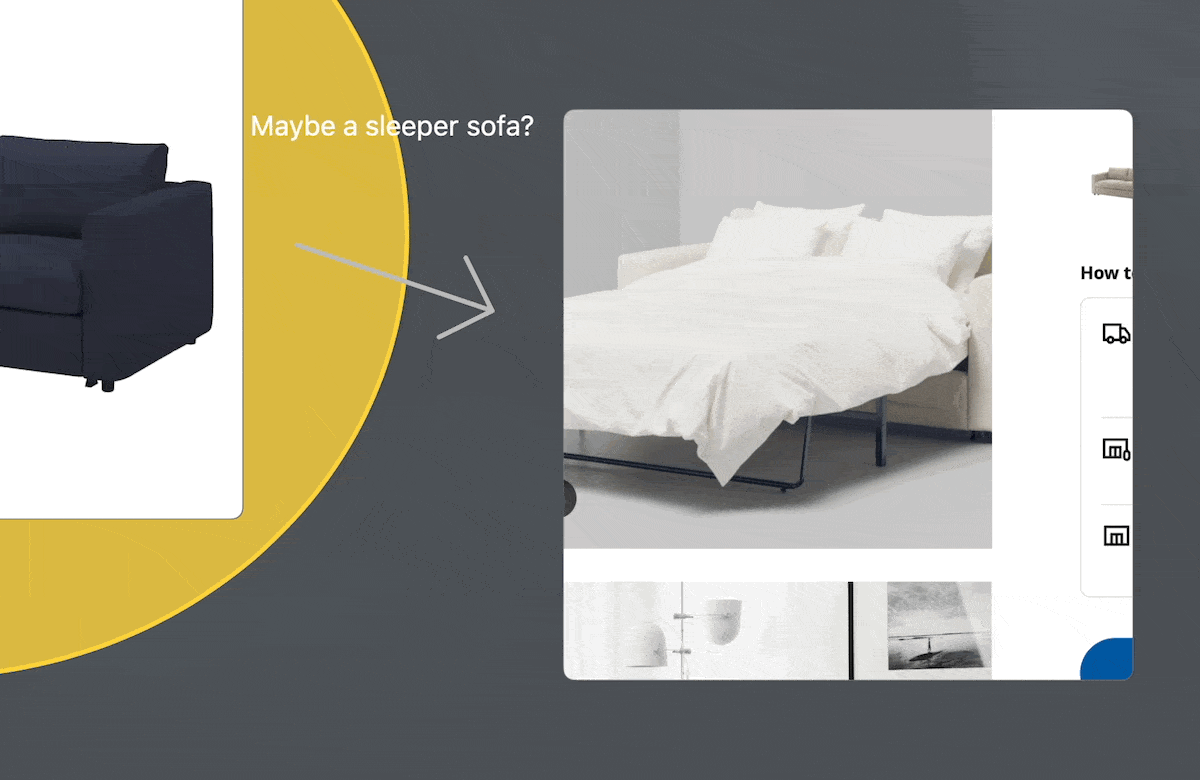
The craziest part? They feature a LIVE mode. Let’s say you take a snippet of the weather of your hometown from Google and save it to your easel. At any time, you can visit the easel and press the “play” button, and Arc will update the easel in real-time! I’ve used this feature to track packages and share research with my team. Others have used it to make personalized dashboards to feature live info. You really need to try it for yourself!
Boosts
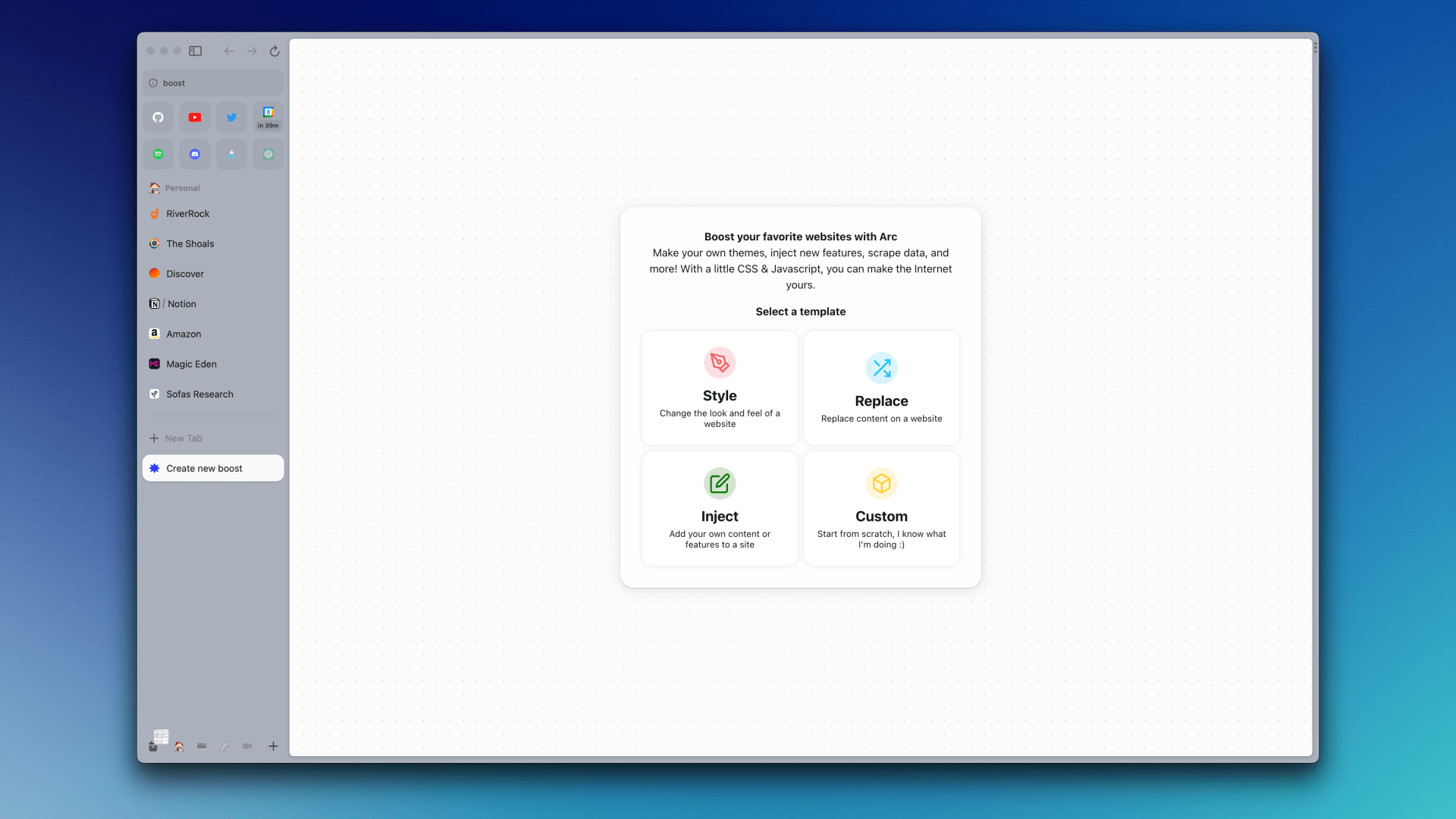
Arc has an affinity to bring back the excitement of the internet from the 90s, both in design and in customization. Not only does Arc feature themes for your browser to personalize your experience, they give you the ability to do “Boosts” to websites. Boosts are simply CSS or JS injections to websites so you can customize the color of a website or give it additional functionality.
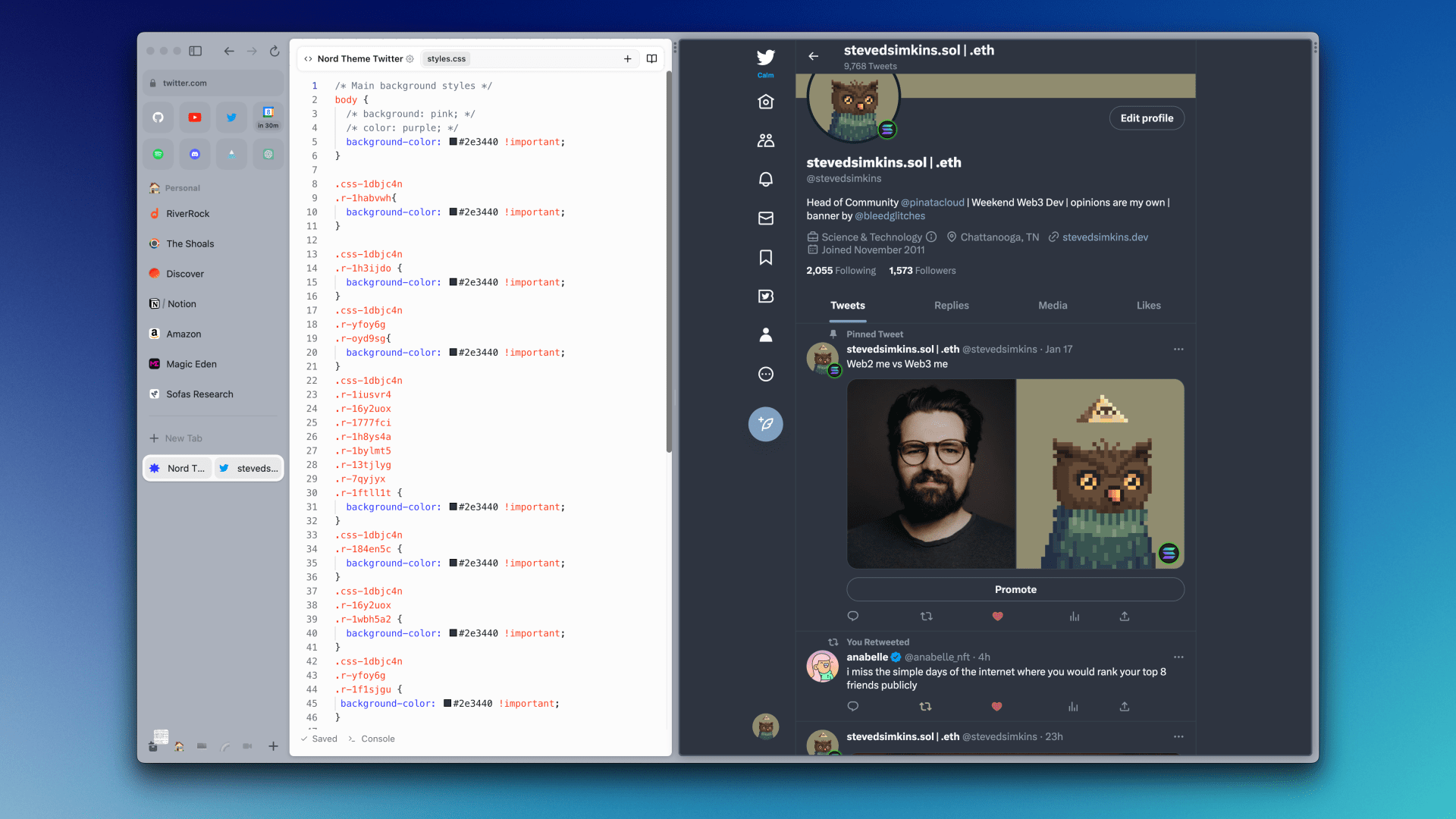
As someone who is obsessed with customizing the personal computer environment, I absolutely love Boosts. Nord is one of my favorite color palettes, and I use it for as many ports as I can. With Boosts, I’ve been able to customize all my regular sites to give it some flare. This comes a bit naturally for me since I have some web development experience and know how to snag CSS selectors easily, however, there are possibilities for Boosts to become a marketplace feature where non-technical users could save and use Boosts made by others.
One App to Rule Them All
A fun fact about most applications running on your computer: they’re likely Electron apps. Electron is a framework for building desktop applications, and it uses web languages like Javascript. In a lot of ways, Electron apps are just web browsers. Most apps in this format work in your web browser too, like Slack, Spotify, Discord, etc. My personal computer operated like this: I had a dozen apps downloaded for individual web applications. Why? 1. It was cumbersome to use them in my web browser, and 2. I thought it would be more performant than using the web browser (it was not). Arc solved both of those problems for me.
This goes back to how Arc manages pinned tabs. Since it has the ability to treat websites like applications, it makes it much easier to access them and use them. Instead of having a bunch of tabs on the top of my browser where Slack could get lost, I can always find it in my pinned tabs on my sidebar. Within two days of adjusting to Arc, I was able to delete all of my excess Electron apps. Now instead of running ten apps at once, I run maybe two or three, with Arc being the heavy lifter. When I’m not using apps, I can simply close them out but keep it pinned in my tabs for easy access later on.
Internet Computers
That last point brings us to the concept of Internet Computers that Josh, the CEO of The Browser Company, talks about in videofile_ : the internet computer. He essentially breaks down how most of our lives run on applications in the cloud rather than the computers we use, whether it’s our work, our photos and videos, or our entertainment; it doesn’t live locally. An Internet Computer is a fluid concept without definition, but perhaps could look like
I can tap my finger on the device, or I can toss at a glance and whoosh: my computer comes down from the internet, comes down from the cloud, and is right there on that machine. Because all of the stuff I need, all of my tools, all of my files, all of my people, my teams, all of those things are out there on the internet too so it doesn’t matter where I access it from.
Josh talks about this as a possible reality in five to ten years, but to be honest, it feels like we could be so much closer. Arc is already an app that can do just about anything you need it to do, thanks to the power of developers building web applications. Of course, there are limitations with heavier software, and there is still a lot of work to be done, but the concept of a computer that lives in the cloud and could seamlessly travel between your phone, your computer, or your partner’s tablet, really excites me!
I can also see some possibilities of Web3 being part of this future, where your crypto wallet could be used as your internet identity. Your assets and funds could be used with an Internet computer to send tokens, vote on proposals, or integrate digital collectibles. The future of crypto and blockchain is still muddy and has a lot of work before it becomes a reality, yet it’s easy to visualize something like this.
Join the Arc Side
Whatever the future might hold, Arc and its incredible features are available now! At the time of this blogpost it is only available on MacOS, but the team is currently building out a mobile app as well as a Windows version. It is also only accessed by invite only. however there are many being passed around. My best suggestion is to check out their Discord where they have a channel for invite codes, or if you want, you can email me, and I’ll give out what I can! 😁
I appreciate everything The Browser Company has accomplished so far, and I wish them the best as they attempt to revolutionize the way we experience the Internet!